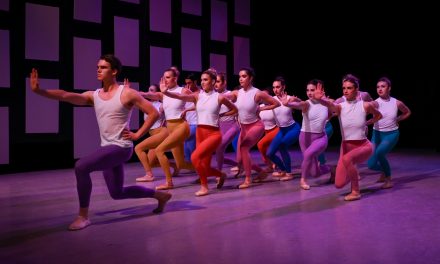“Baby… Baby…Baaaby,” the two xirls Julia “JulieXirl” Eichten and Juniper “Juniper XR” Rose say to each other. They are back-to-back, looking for the other and following the sound of their voice. Rose adds a little melodic flair to her “baby.” The audience chuckles.
In CrawlSpace LA’s second volume of “Spare Change,” the voice takes the leading role in the three works presented. Each performance utilized the element differently as a translator or a channel for the innermost truths. Its execution throughout the evening performance on Nov. 6 highlighted the value of sound and its ability to move with the body.
Eichten and Rose’s performance was an exercise in communal care. It begins with Eichten putting her weight on the wall as Rose sings at a keyboard piano. Eichten pushes into the wall with her shoulder, back, head, and even upside down with her feet. A magnetizing exploration leads her to her next form of support: Rose’s forehead.
Together, they sing “Just A Xirl” — a riff off No Doubt’s “Just A Girl.” They move around the space forehead-to-forehead singing acapella. It’s both comical and haunting. Once the reference comes to mind, images of Gwen Stefani in the 90s surface. However, as Eichten and Rose sing “I’m just a xirl, what’s my destiny? What I’ve succumbed to is making me numb,” it is just us and the lyrics of Stefani’s interrogation of a patriarchal society. Following the election of Donald Trump, the lyrics pierce through the heart. At a time when the future of our rights is in question, two xirls singing about the struggles of being a xirl in a world where men in power feel the need to dictate their livelihood has incredible weight in the room. “I’ve had it up to here,” they sing, finding comfort in each other’s support.
In the final moments of their performance, Eichten instructs Rose, “Give me your weight.” Together, they find ways to offer and accept support from each other. Their movement is assisted by vocal instruction and invitation.
Nach’s solo in the middle of the program centered on her own exploration of her movement style. Nach’s dance background is in Krump and has recently gravitated to ballet. By unifying them, she finds new ways of storytelling. She shifts from fast chest pops and arm swings to slow, exaggerated extensions. Its unity is mesmerizing.
In the middle of the performance, there was supposed to be music. Technical difficulties. She keeps going. Instead, she explains herself. She’s discovering new ways of walking, she says. Nach shows two ways of walking — two Krump stomps — and then shows two new ways of walking — a series of tendus and a Relève in fifth position. The voice is well-utilized here, instructing you where to look. She tells us to look at her feet or arms as she guides us through her exploration, verbalizing her discoveries as she comes across them. As a result, you learn more about Nach and her process of creating movement.
“Maybe I was lucky there was no music,” she says with a smile at the end of the solo.
The last performance used voice as a way of conjuring the truth from within. Annalise Gehling and Keilan Stafford collaborated on a piece mixed with erotic movement and vulnerable monologues, exposing their exterior and interior.
The first moments are filled with moans and groans. Together, the two artists walk to the corner of the space — stoic — and back to a pair of chairs at the other corner. They quickly straddle, grope and hump the chair. They’ve established a sexual relationship with the piece of furniture. As Stafford merges a bit deeper with the chair, he grabs a mic that distorts his voice into a deeper, godly tone.
“I have -$400 in my bank account,” he admits. “It’s so difficult being a freelance artist.”
In a stream of consciousness, he shares the struggles of waiting for a check to arrive and struggling to find work in L.A. As he says how difficult it is, he finds himself in a difficult position on the chair with his back arched over the seat and his limbs clinging to the chair legs. His once fluid and rapid movement becomes unstable.
“I’m holding on,” he says into the mic as he lands on his two feet with the chair hanging between his legs. He’s still while Gehling takes the brunt of the statement, thrashing in the corner and screaming the same words. The voice helps dig up emotions from within, allowing the performers to embody them in provocative ways. Throughout the program, it becomes clear that the voice is a powerful tool in movement storytelling. It can grab your attention and give each movement a voice of its own. Each lean, step and thrash is instructed by the voice and tells you how they feel. Listen.
To learn more about CrawlSpace LA, please visit their website.
Written by Steven Vargas for LA Dance Chronicle.
Featured image: Spare Change Vol. II – Annelise Gehling and Keilan Stafford – Photo by Megan Rose.












